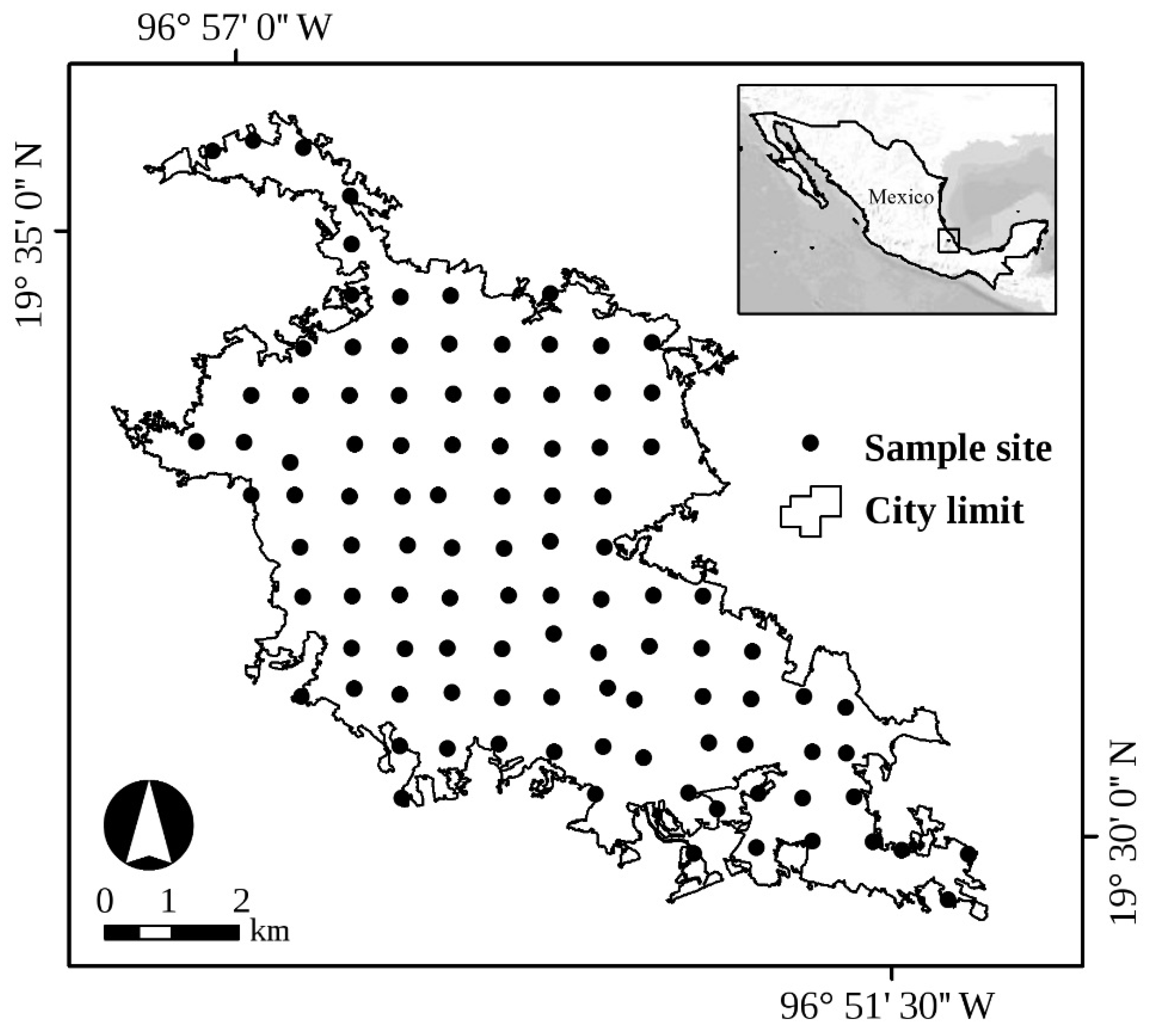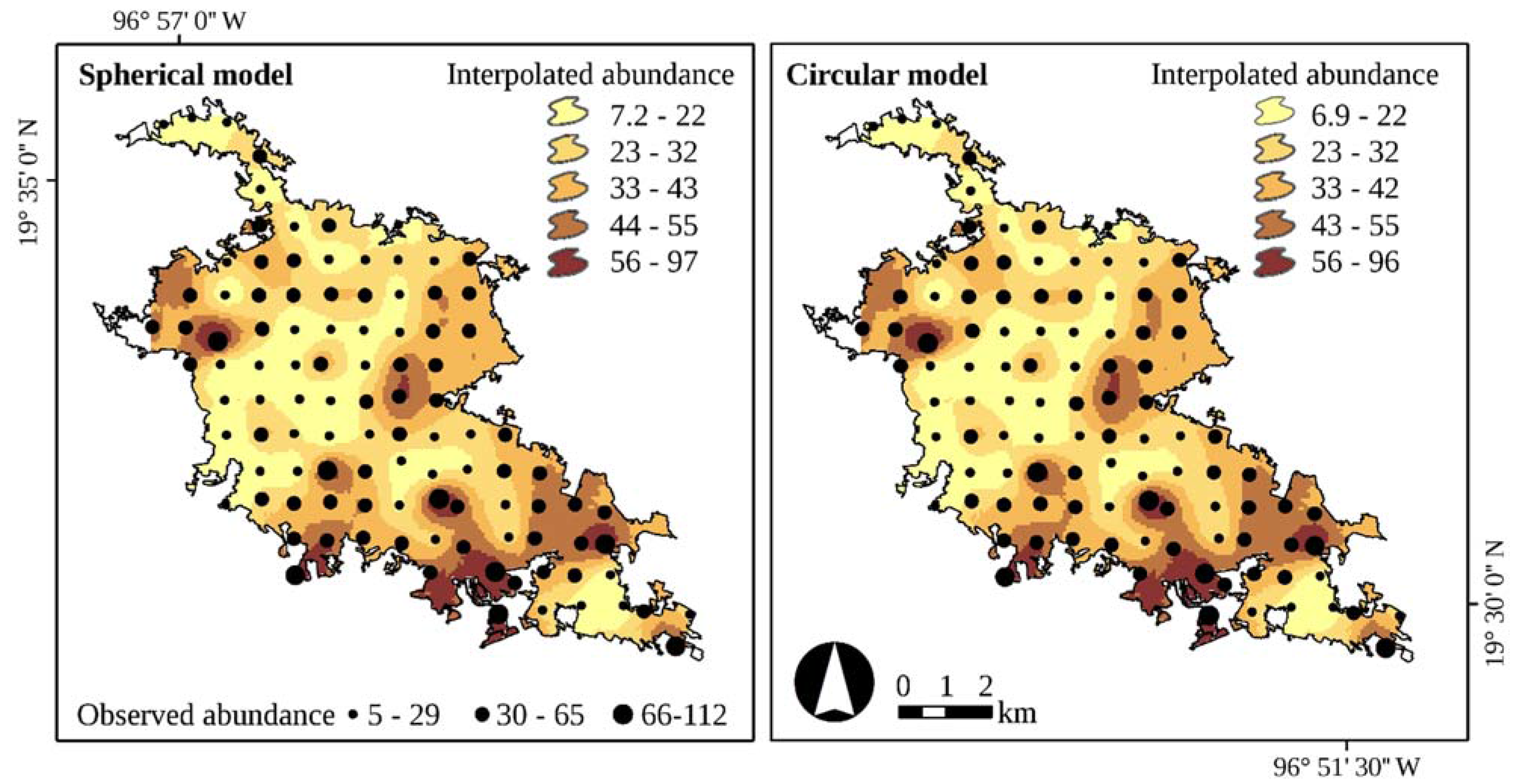How Many Butterflies Are There in a City of Circa Half a Million People?
Abstract
:1. Introduction

2. Results and Discussion


3. Materials and Methods
3.1. Study Area
3.2. Butterfly Surveys
3.3. Data Analysis
| Model | Range | Sill Variance | Nugget Variance | Mean sq. Residuals |
|---|---|---|---|---|
| Linear | 0.0004 | 1.995 | 0.2112 | |
| Exponential | 339.9 | 3.4180 | −0.343 | 0.0126 |
| Circular | 976.3 | 2.4740 | 0.568 | 0.0158 |
| Spherical | 1089.0 | 2.5240 | 0.519 | 0.0158 |
Acknowledgments
Author Contributions
Conflicts of Interest
References
- Department of Economic and Social Affairs, Population Division, United Nations. World Urbanization Prospects: The 2014 Revision, Highlights (ST/ESA/SER.A/352); United Nations: New York, NY, USA, 2014. [Google Scholar]
- Buhaug, H.; Urdal, H. An urbanization bomb? Population growth and social disorder in cities. Glob. Environ. Chang. 2013, 23, 1–10. [Google Scholar] [CrossRef]
- Vitousek, P.M.; Mooney, H.A.; Lubchenco, J.; Melillo, J.M. Human domination of Earth’s ecosystems. Science 1997, 277, 494–499. [Google Scholar] [CrossRef]
- Tilden, J. San Francisco’s vanishing butterflies. Lepid. News 1956, 10, 133–145. [Google Scholar]
- Shapiro, A.M.; Shapiro, A.R. The ecological associations of the butterflies of Staten Island. J. Res. Lepid. 1973, 12, 65–128. [Google Scholar]
- Czech, B.; Krausman, P.R.; Devers, P.K. Economic associations among causes of species endangerment in the United States. Bioscience 2000, 50, 593–601. [Google Scholar] [CrossRef] [Green Version]
- McKinney, M.L. Effects of urbanization on species richness: A review of plants and animals. Urban Ecosyst. 2008, 11, 161–176. [Google Scholar] [CrossRef]
- Pickett, S.T.A.; Boone, C.G.; McGrath, B.P.; Cadenasso, M.L.; Childers, D.L.; Ogden, L.A.; McHale, M.; Grove, J.M. Ecological science and transformation to the sustainable city. Cities 2013, 32, S10–S20. [Google Scholar] [CrossRef]
- Voinov, A.; Farley, J. Reconciling sustainability, systems theory and discounting. Ecol. Econ. 2007, 63, 104–113. [Google Scholar] [CrossRef]
- McCaffrey, R.E.; Turner, W.R.; Borens, A.J. A new approach to urban bird monitoring. Urban Bird Ecol. Conserv. 2012, 45, 139–154. [Google Scholar]
- Dearborn, D.C.; Kark, S. Motivations for conserving urban biodiversity. Conserv. Biol. 2010, 24, 432–440. [Google Scholar] [CrossRef] [PubMed]
- McDonnell, M.J.; Hahs, A.K. The future of urban biodiversity research: Moving beyond the “low-hanging fruit”. Urban Ecosyst. 2013, 16, 397–409. [Google Scholar] [CrossRef]
- Brown, K.S., Jr.; Freitas, V.A.L. Butterfly communities of urban forest fragments in Campinas, Sao Paulo, Brazil: Structure, instability, environmental correlates, and conservation. J. Insect Conserv. 2002, 6, 217–231. [Google Scholar] [CrossRef]
- Bergerot, B.; Merckx, T.; van Dyck, H.; Baguette, M. Habitat fragmentation impacts mobility in a common and widespread woodland butterfly: Do sexes respond differently? BMC Ecol. 2012, 12, Article 5. [Google Scholar] [CrossRef] [PubMed]
- Bergerot, B.; Fontaine, B.; Renard, M.; Cadi, A.; Julliard, R. Preferences for exotic flowers do not promote urban life in butterflies. Landsc. Urban Plan. 2010, 96, 98–107. [Google Scholar] [CrossRef]
- Ortega-Álvarez, R.; MacGregor-Fors, I. Spreading the word: The ecology of urban birds outside the United States, Canada and Western Europe. Auk 2011, 128, 415–418. [Google Scholar] [CrossRef]
- Aronson, M.F.J.; la Sorte, F.A.; Nilon, C.H.; Katti, M.; Goddard, M.A.; Lepczyk, C.A.; Warren, P.S.; Williams, S.G.; Cilliers, S.; Clarkson, B.; et al. A global analysis of the impacts of urbanization on bird and plant diversity reveals key anthropogenic drivers. Proc. R. Soc. B 2014, 281. [Google Scholar] [CrossRef] [PubMed]
- Ortega-Álvarez, R.; MacGregor-Fors, I. Living in the big city: Effects of urban land-use on bird community structure, diversity, and composition. Landsc. Urban Plan. 2009, 90, 189–195. [Google Scholar] [CrossRef]
- Leveau, C.M.; Leveau, L.M. Avian community response to urbanization in the Pampean region, Argentina. Ornitol. Neotrop. 2005, 16, 503–510. [Google Scholar]
- Ramírez Restrepo, L.; Halffter, G. Butterfly diversity in a regional urbanization mosaic in two Mexican cities. Landsc. Urban Plan. 2013, 115, 39–48. [Google Scholar] [CrossRef]
- Lepczyk, C.A.; Flather, C.H.; Radeloff, V.C.; Pidgeon, A.M.; Hammer, R.B.; Liu, J. Human impacts on regional avian diversity and abundance. Conserv. Biol. 2008, 22, 405–416. [Google Scholar] [CrossRef] [PubMed]
- Ortega-Álvarez, R.; MacGregor-Fors, I. Dusting-off the file: A review of knowledge on urban ornithology in Latin America. Landsc. Urban Plan. 2011, 101, 1–10. [Google Scholar] [CrossRef]
- Dallimer, M.; Rouquette, J.R.; Skinner, A.M.J.; Armsworth, P.R.; Maltby, L.M.; Warren, P.H.; Gaston, K.J. Contrasting patterns in species richness of birds, butterflies and plants along riparian corridors in an urban landscape. Divers. Distrib. 2012. [Google Scholar] [CrossRef]
- Sandström, U.G.; Angelstam, P.; Mikusiński, G. Ecological diversity of birds in relation to the structure of urban green space. Landsc. Urban Plan. 2006, 77, 39–53. [Google Scholar] [CrossRef]
- McIntyre, N.E. Ecology of urban arthropods: A review and a call to action. Ann. Entomol. Soc. Am. 2000, 93, 825–835. [Google Scholar] [CrossRef]
- Kellert, S.R. Values and perceptions of invertebrates. Conserv. Biol. 1993, 7, 845–855. [Google Scholar] [CrossRef]
- Bergerot, B.; Tournant, P.; Moussus, J.P.; Stevens, V.M.; Julliard, R.; Baguette, M.; Foltête, J.C. Coupling inter-patch movement models and landscape graph to assess functional connectivity. Popul. Ecol. 2013, 55, 193–203. [Google Scholar] [CrossRef]
- Thomas, J.A. Monitoring change in the abundance and distribution of insects using butterflies and other indicator groups. Philos. Trans. R. Soc. Lond. B Biol. Sci. 2005, 360, 339–357. [Google Scholar] [CrossRef] [PubMed]
- Turner, W.R.; Nakamura, T.; Dinetti, M. Global Urbanization and the Separation of Humans from Nature. Bioscience 2004, 54, 585. [Google Scholar] [CrossRef]
- Ruszczyk, A. Distribution and abundance of butterflies in the urbanization zones of Porto Alegre, Brazil. J. Res. Lepid. 1986, 25, 157–178. [Google Scholar]
- Ruszczyk, A.; Mellender de Araujo, A. Gradients in butterfly species diversity in an urban area in Brazil. J. Lepid. Soc. 1992, 46, 255–264. [Google Scholar]
- Fuller, R.A.; Tratalos, J.; Gaston, K.J. How many birds are there in a city of half a million people? Divers. Distrib. 2009, 15, 328–337. [Google Scholar] [CrossRef]
- Walker, J.S.; Balling, R.C.; Briggs, J.M.; Katti, M.; Warren, P.S.; Wentz, E.A. Birds of a feather: Interpolating distribution patterns of urban birds. Comput. Environ. Urban Syst. 2008, 32, 19–28. [Google Scholar] [CrossRef]
- Hernández Baz, F. La fauna de Mariposas (Lepidoptera: Rhopalocera) de Xalapa, Veracruz, Mexico. La Ciencia y el Hombre 1993, 14, 55–88. (In Spanish) [Google Scholar]
- Butterflies of America. Available online: butterfliesofamerica.com. (accessed on 20 January 2015).
- McGill, B.J.; Etienne, R.S.; Gray, J.S.; Alonso, D.; Anderson, M.J.; Benecha, H.K.; Dornelas, M.; Enquist, B.J.; Green, J.L.; He, F.; et al. Species abundance distributions: Moving beyond single prediction theories to integration within an ecological framework. Ecol. Lett. 2007, 10, 995–1015. [Google Scholar] [CrossRef] [PubMed]
- Ehrlich, P.R.; Raven, P.H. Butterflies and plants: A study in coevolution. Evolution 1964, 18, 586–608. [Google Scholar] [CrossRef]
- Pin Koh, L.; Sodhi, N.S. Importance of reserves, fragments, and parks for butterfly conservation in a tropical urban landscape. Ecol. Appl. 2004, 14, 1695–1708. [Google Scholar]
- Miller, J.R.; Hobbs, R.J. Conservation where people live and work. Conserv. Biol. 2002, 16, 330–337. [Google Scholar] [CrossRef]
- MacGregor-Fors, I.; Avendaño-Reyes, S.; Bandala, V.M.; Chacón-Zapata, S.; Díaz-Toribio, M.H.; González-García, F.; Lorea-Hernández, F.; Martínez-Gómez, J.; Montes de Oca, E.; Montoya, L.; et al. Multi-taxonomic diversity patterns in a neotropical green city: A rapid biological assessment. Urban Ecosyst. 2015, 18, 633–647. [Google Scholar] [CrossRef]
- Rosenzweig, M. Win-Win Ecology—How the Earth’s Species Can Survive in the Midst of Human Enterprise; Oxford University Press: New York, NY, USA, 2003; p. 224. [Google Scholar]
- Instituto Nacional de Estadística Geografía e Informática (INEGI). Censo de Población y Vivienda 2010; INEGI: Aguascalientes, Mexico, 2011. (In Spanish) [Google Scholar]
- INEGI. Censo de Población y Vivienda 1980; INEGI: Aguascalientes, Mexico, 1980. (In Spanish) [Google Scholar]
- INEGI. Censo de población y vivienda 1990; INEGI: Aguascalientes, Mexico, 1990. (In Spanish) [Google Scholar]
- INEGI. Censo de población y vivienda 2000; INEGI: Aguascalientes, Mexico, 2000. (In Spanish) [Google Scholar]
- Benítez, G.; Pérez-Vázquez, A.; Nava-Tablada, M.; Equihua, M.; Álvarez-Palacios, J.L. Urban expansion and the environmental effects of informal settlements on the outskirts of Xalapa city, Veracruz, Mexico. Environ. Urban 2012, 24, 149–166. [Google Scholar] [CrossRef]
- Lemoine-Rodríguez, R. Cambios en la Cobertura Vegetal de la Ciudad de Xalapa-Enríquez, Veracruz y Zonas Circundantes Entre 1950 y 2010. Bachelor’s Thesis, Universidad Veracruzana, Xalapa, Mexico, 2012. [Google Scholar]
- MacGregor-Fors, I. How to measure the urban-wildland ecotone: Redefining “peri-urban” areas. Ecol. Res. 2010, 25, 883–887. [Google Scholar] [CrossRef]
- Ruxton, G.; Colegrave, N. Experimental Design for the Life Sciences; Oxford University Press: Oxford, UK, 2010. [Google Scholar]
- Payne, R.W.; Murray, D.A.; Harding, S.A.; Baird, D.B.; Soutar, D.M. GenStat for Windows, 11th ed.; VSN Introduction: England, UK, 2008. [Google Scholar]
- Oliver, M.A. The variogram and kriging. In Handbook of Applied Spatial Analysis: Software Tools, Methods and Applications; Fischer, M.M., Getis, A., Eds.; Springer Science & Business Media: Berlin, Germany, 2009; pp. 319–352. [Google Scholar]
- Sauer, J.R.; Pendleton, G.W.; Orsillo, S. Mapping of Bird Distributions from Point Count Surveys. Monitoring Bird Populations by Point Counts; US Department of Agriculture, Forest Service General Technical Report PSW-GTR-149; Pacific Southwest Research Station: Albany, CA, USA, 1995; pp. 151–160. [Google Scholar]
- Valley, R.D.; Drake, M.T.; Anderson, C.S. Evaluation of alternative interpolation techniques for the mapping of remotely-sensed submersed vegetation abundance. Aquat. Bot. 2005, 81, 13–25. [Google Scholar] [CrossRef]
- Pebesma, E.J.; Duin, R.N.; Burrough, P.A. Mapping sea bird densities over the North Sea: Spatially aggregated estimates and temporal changes. Environmetrics 2005, 16, 573–587. [Google Scholar] [CrossRef]
- Lin, Y.P.; Yeh, M.S.; Deng, D.P.; Wang, Y.C. Geostatistical approaches and optimal additional sampling schemes for spatial patterns and future sampling of bird diversity. Glob. Ecol. Biogeogr. 2008, 17, 175–188. [Google Scholar] [CrossRef]
© 2015 by the authors; licensee MDPI, Basel, Switzerland. This article is an open access article distributed under the terms and conditions of the Creative Commons Attribution license (http://creativecommons.org/licenses/by/4.0/).
Share and Cite
Ramírez-Restrepo, L.; Cultid-Medina, C.A.; MacGregor-Fors, I. How Many Butterflies Are There in a City of Circa Half a Million People? Sustainability 2015, 7, 8587-8597. https://doi.org/10.3390/su7078587
Ramírez-Restrepo L, Cultid-Medina CA, MacGregor-Fors I. How Many Butterflies Are There in a City of Circa Half a Million People? Sustainability. 2015; 7(7):8587-8597. https://doi.org/10.3390/su7078587
Chicago/Turabian StyleRamírez-Restrepo, Lorena, Carlos Andrés Cultid-Medina, and Ian MacGregor-Fors. 2015. "How Many Butterflies Are There in a City of Circa Half a Million People?" Sustainability 7, no. 7: 8587-8597. https://doi.org/10.3390/su7078587






